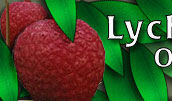Litchis and Longans
By DAVID KARP
NY Times lychee article from 1996:
Most Americans know litchis only as syrupy canned fruit or raisin-like
dried “litchi nuts,” missing entirely the succulence and fragrance of
the delicacy the Chinese have prized for millennia. Though increasingly
available in mainstream markets, fresh litchis, now at peak season,
remains primarily an Asian specialty item. Aficionados head to
Chinatown for clusters of the rosy ping pong ball–size fruit, still
attached to leafy stems. To eat a litchi, they peel the thin, slightly
leathery and spiky skin, pull the translucent white flesh from the
glossy brown seed, and savor the texture and flavor reminiscent of a
muscat grape.
“Nothing beats the perfumed lusciousness of a litchi right off the
tree,” said Noble Hendrix, a former surgeon who fell in love with
litchis and is now a leading grower, in Homestead, Fla. “But we provide
the next best thing by picking in the morning and flying the fruit to
New York that afternoon, so it’s on sale the next day.”
Florida litchis arrived in stores last week and will be available
through the end of the month. The first commercial groves flourished in
the 1950’s on the state’s central ridge, but a disastrous freeze in
1958 virtually destroyed the industry. In recent decades cultivation
revived around Homestead in southern Dade County, only to be devastated
in August 1992 by Hurricane Andrew, which stripped the trees of limbs
and leaves. Afterwards growers replanted up to 500 acres, producing
almost half a million pounds of fruit yearly, which should more than
triple in a few years as new trees mature.
Florida growers raise two main varieties: the early-season Mauritius
has skin tinged with green, and is crisper and less sweet than the
late-season Brewster, which is a brilliant, almost iridescent
purplish-red. On a scale of 1 to 10, Dr. Robert Knight, a litchi expert
at the University of Florida at Homestead, rates the Mauritius a 4 and
the Brewster a 6 or 7, but the Mauritius has predominated in recent
years because it bears more heavily.
The best litchis, the 9’s and 10’s, grow in Guangdong and Fujian
provinces in southern China, the fruit’s homeland. The local climate,
hot and rainy in summer and cool in winter, perfectly suits the
attractive evergreen litchi trees, which grow beside waterways and on
terraced hillsides. For centuries landowners vied in procuring the
finest varieties, including the ‘glutinous rice dumpling,’ famous for
its tiny “chicken-tongue” seeds, and the fabulously fragrant and
expensive ‘hanging green’ — as well as the ‘rhinoceros horn,’ the
‘round rump,’ and the ‘imperial concubine’s laugh.’ The last
commemorates the celebrated Lady Yang, whose passion for litchis,
fetched at great cost by the imperial courier service, helped cause the
downfall of her lover, the emperor Hsüan Tsung, in 756 A.D. Litchis
inspired countless poems, paintings, and elaborate treatises, and in
the Ming Dynasty clubs of devotees met in temples and gardens to
consume hundreds at a sitting. Today Hong Kong litchi lovers flock to
public orchards to pick their own fruit and enjoy it at picnics in the
shade of the litchi groves.
Experts usually say “lye-chee” rather than “lee-chee,” favoring the
Cantonese over the Mandarin pronunciation, but either is correct;
“lychee” is also a common variant spelling. “Litchi nut,” however,
properly refers only to the dried fruit commonly sold in Chinese
groceries, alongside tea soaked in litchi juice, honey from litchi
blossoms, and litchi soda.
In this country the demand for fresh litchis, mostly from
Asian-Americans, exceeds the domestic supply, but U.S. Department of
Agriculture regulations have restricted imports, for fear of foreign
fruit flies. Lured by prices of $3 to $7 a pound, smugglers bring in
Asian litchis transshipped through Canada, where they are permitted
because tropical pests do not survive the cold.
To counter this furtive trade, the U.S.D.A. recently legalized fresh
litchis from China, Taiwan and India, the world’s largest producers.
However, this fruit must undergo about two weeks of cold treatment to
kill insects, leaving the shells brown and brittle, and sometimes
causing the flavor to be off.
“The cold is crucial, but cruel for the litchis,” said James Lee, a
distributor of Asian produce in Monterey Park, Calif. “Customers prefer
bright red skin — it’s too early to tell if the treated fruit will
succeed.”
The season for Asian imports runs from early May to July; then Mexican
fruit arrives, followed in August and September by Israeli litchis,
treated with sulfites to preserve color. California has only a few
small groves, but Hawaii, where the high cost of labor has forced
100,000 acres of sugar cane out of production, may soon be a major
source: Shipments of the islands’ litchis, irradiated on the mainland
to eliminate pests, will be approved later this year, if not this
summer, said Peter Grosser, who supervises imports at the U.S.D.A.’s
Plant Protection and Quarantine division. What’s more, Hawaiian growers
are placing big bets that the outlandish-looking rambutan, a tropical
relative of the litchi with wild wavy tendrils and crisper flesh, will
soon get the green light.
The litchi’s closest cousin, however, is the longan, a smaller fruit
that has a yellow-brown shell and a mellow musky flavor with hints of
honeydew and gardenia. The name means “dragon’s eye,” which the fruit’s
black seed is said to resemble; the longan is also called the “slave of
the litchi,” as its season trails behind — in Florida, it runs from the
third week of July through August. Because the longan is not as fussy
about climatic conditions as the litchi, it is more profitable for
Floridian growers, and production is increasing more rapidly. Some say
longans are not as juicy and aromatic as litchis, but customers from
Indochina, where longans abound, prefer them.
Though the longan is less important than the litchi as a fresh fruit,
it is more widely used in traditional Chinese medicine, in dried form.
Ginseng and herbal medicine stores, as well as food shops, often carry
the sweet pulps; the best quality are light in color and more
delicately flavored than the smoky second grade. Categorized as “warm”
in the Chinese medical system (as is the litchi), dried longan is used,
in combination with other ingredients, to tonify and nourish the blood,
calm the spirit, and provide energy; it is often given in a restorative
tea or soup to women after childbirth, or to treat pensiveness and
overwork.
When shopping for fresh litchis in Chinatown, I follow a triangular
route, looking first at fruit markets on Mott or Mulberry Street in the
blocks near Canal Street, then on Chatham Square and East Broadway, and
finally on Grand Street. The best litchis are sold in traditional
bundles with stems and leaves, though loose ones cost less. Look for
bright red fruit, avoiding “leakers” with broken skins. Litchis taste
best soon after purchase, but can be stored in the refrigerator about a
week. Beware: fresh litchis are addictively irresistible, and the
Chinese believe that overindulgence causes fever and nosebleed.
Chinatown Ice Cream Factory 65 Bayard Street; (212) 608-4170. Litchi
ice cream.
H.C. Ginsen Co. 87A East Broadway; (212) 566-3311. Top-quality dried
longans.
Heng Cheung Market 39 East Broadway; (212) 589-4859. Fresh litchis
and longans.
Kam Man Food 200 Canal Street, at Mott Street; (212) 571-0330. Dried
litchis and longans, litchi honey.
Mott Street Fruit Stand Corner of Chatham Square near Mott Street; no
phone. Best fresh litchis and longans.
|
|
|
Copyright © 1999-2010 Lychees Online
info@lycheesonline.com www.lycheesonline.com (954)648-6020
|

